► M5 vs performance execs
► AWD is now the way to go
► The best supersaloons on sale
Mercedes Benz might claim to have invented the modern supersaloon with its mighty SEL 6.9 back in the mid-’70s, but it was the BMW M5 that perfected the art a decade later. And for over 30 years the best supersaloon recipe has remained broadly similar: a stonking great engine stuffed into a rear-drive chassis and clothed with a discreet four-door bodyshell. They have enduring appeal and deservedly some of the best cars on sale today.
But not any longer. Just as the sugar tax has changed the composition of our favourite evil drinks without impacting their visual appeal, so has the realisation that supercar-grade power is now too much for the average Joe to handle in less than ideal conditions, and quite possibly slower and less fun as a result.
So the new BMW M5 is four-wheel drive. But it’s a smart four-wheel drive, allowing you to choose whether you want both axles to do the driving, or just the rear. And although four-wheel drive almost always means more mass, BMW has ditched enough weight in other areas to deliver a new car that’s actually lighter than the old. And more powerful. It’s a win-win situation, though you’ll need to already be a winner to sample one: prices start at £89,705 before options.
But the M5 doesn’t have things all its own way. Mercedes-AMG already switched to a similarly smart four-wheel-drive system for the £89,290 E63 almost 18 months ago. That’s the E63 with the spectacular cabin, the one that trumps the M5 by coming in both saloon and estate guises (an M5 wagon is rumoured but not confirmed), and whose AMG badge is now viewed with at least as much respect as BMW’s simple letter M.
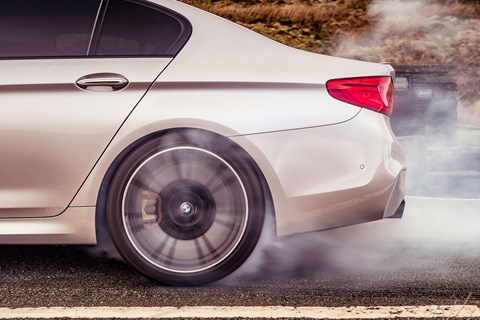
The Benz might have the right badge, but it’s not the rightest. If you want to brag, a Porsche keyfob is still a seriously powerful tool to do it, and in the case of the second-generation Panamera there’s every reason to believe the car it’s connected to can back up the bravado. You need nothing less than a full-blown – in every sense – Panamera Turbo to keep pace with this company, so that’s what we’ve got here. Ordinarily that would mean a price of £115,100, but we’ve opted for the more practical Sport Turismo estate version, which commands a £2147 premium but actually only offers 25 litres more luggage space.
If it’s practicality and usability you’re after the RS6 has always been the go-to sledgehammer sedan. Except that since 2013 it’s been available exclusively as an estate. We’ve already driven the new A6, meaning this £86,460 RS6 Performance dies soon, and its all-wheel-drive USP has been eroded by rivals’ adoption of four-wheel-drive tech. But it makes the cut in this test because it’s still über desirable.
It’s raining, it’s pouring…
They’re all desirable today; it’s lashing down in Wales, the perfect reminder of how welcome four-wheel drive can be on a serious performance car. And a perfect reminder of how much fun it can be too, when properly
executed. Which may well be our fate if we’re clocked at these unprintable speeds as we haul ass out of Bala, along the A4212 and up towards our rendezvous point, our collective 2335bhp spread across eight axles giving all four drivers the confidence to keep those throttles pinned in a way that’d require a whole pharmacy of brave pills in 600bhp rear-drivers.
Even at traffic-jam speeds you need a touch of bravado just to be seen driving the Panamera. Despite wearing subtle silver paint it draws attention everywhere, and not all of those glances will be admiring. Panamera 2 is certainly more handsome than the hunchback original, but it looks better as a hatch than as this Sport Turismo estate, and we can’t summon much love for either now that we’ve seen the slinky Mission E and its Allroad-inspired Cross Turismo brother.
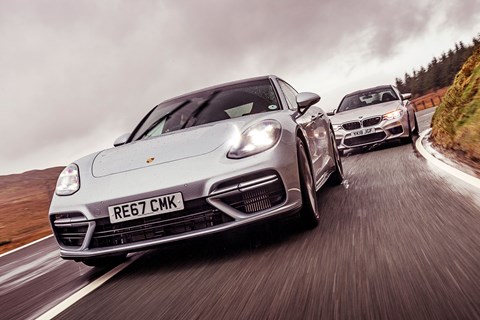
The remaining three play the traditional best supersaloon role to perfection. To the non-car-obsessed there’s nothing to see here but three moderately smart-looking German executive cars with three nice sets of wheels. Certainly nothing to suggest that they’re packing as much heat as a Lamborghini Huracan.
Finding the clues
To those who care, though, it’s all in the details, because those smart wheels are lightweight forgings stuffed under arches teased way out to accommodate them. They might be hiding carbon ceramic brakes if you’ve ticked the right options boxes and those gaping holes in the front bumpers are clearly designed to scavenge air to cool hungry motors. Of the three it’s the Audi, with its shouty honeycomb grille and Quattro lettering, that’s the most overt, even in this car’s demure metallic blue.
It’s followed by the Benz, whose twin horizontal grille bars mark it out from a non-AMG E-Class, whose ‘V8 biturbo’ badges on the front wings clue you into exactly what the differences are, and whose S suffix on the bootlid tells you this is the punchier of the two available E63 models.
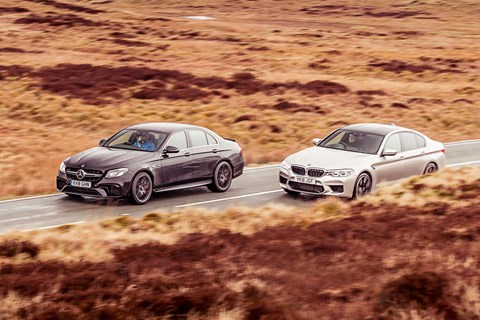
The stealthiest of all is the M5. You get the sculpted bumpers, of course, the quad pipes that arrived in ’98 when the third-generation car landed, a smattering of tricolour M badges, including the one adjacent to the number 5 on the boot and, er, that’s about your lot. This is as undercover as supercar performance gets, just as it was back in 1984 when BMW unleashed the very first M5.
That original M5 was powered by a straight-six lifted from the M1 supercar, but the model’s been as big as a V10 before settling on the same turbocharged V8 configuration our three other cars employ. At 4.4 litres the BMW’s eight is the biggest here by almost half a litre, the others coming in at 4.0 litres apiece. Yet the M5 ranks only third in the power stakes, making 592bhp, which is a solid 40bhp more than the 542bhp Porsche, but slightly behind the other pair. Regular RS6s pump out a probably adequate 552bhp, but this RS6 Performance version edges that north to 597bhp for an additional £6915. Impressive, but not enough to outgun the AMG’s 604bhp.
Turn the chat to torque and it’s the AMG again that leads with 627lb ft. But the Porsche sneaks into a surprise second spot with 568lb ft, followed by the BMW with 553lb ft, and last, the Audi with a piffling 516lb ft that sounds so undernourished you imagine it’ll need a salt-flats-style push start to get it going from the lights.
Numbers vs experience
If all these numbers are starting to look like the code you spent an entire Saturday tapping out on your Sinclair Spectrum’s rubber keyboard at the time of the E28 M5’s debut just to make a three-colour pattern flash on your 14-inch portable, I don’t blame you. So let’s forget the on-paper. What really matters is what happens when you unleash those numbers. And what happens is that the BMW erupts in a cloud of vaporised Michelin because you forgot you’d switched it to two-wheel drive, disengaging the front driveshafts. But what happens when you try the same thing again with those two oversights remedied is incredible: you surge into the next dimension like you’re a guinea-pig test rider on Elon’s Hyperloop.
The M5 is wildly, shockingly, fearsomely rapid, pushing you deep into seats (which now look like proper performance items for the first time since the early-’90s). It’s that dizzyingly, slightly scary kind of rapid, the sort that makes it feel like you’re being sucked under a giant wave and are gasping for your last breath. Maybe we’re masochists – we kept our feet in anyway in the name of science and finding out the best supersaloon.
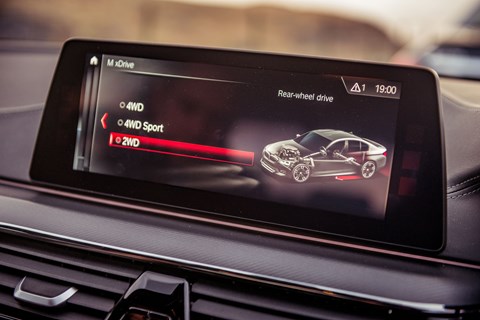
And the amazing thing is that even with 600bhp, even when there seems to be more water on the roads above the Llyn Celyn reservoir than in the pond itself, you really can keep the M5’s right pedal pinned. Gunned from the line like this in four-wheel-drive mode it explodes out of the blocks without a hint of wheelspin, the rev needle flicking around its arc like it’s magnetically drawn to red paint, the car pulling so far ahead of the Porsche as to make a mockery of its identical 3.4sec 0-62mph time. The Porsche digs in incredibly hard off the line too, making use of a really short first gear and a rear tyre that’s a chunky 30mm wider than the BMW’s. But it can’t sustain the effort.
Unlike the M5, which switches from a dual-clutch to conventional eight-speed auto for this generation, the Porsche employs a DCT co-developed with ZF for its longitudinally engined cars. It slices through the ratios quicker than any other transmission here, but it’s not enough to offset an ugly truth: compared to the BMW, the Panamera is down 50bhp, and up 180kg. Inevitably, as the speeds rise the gap grows and the Panamera has to give second best to the M5.
Make that third best, because the AMG is right up there with its Munich rival. Also rated at 3.4sec to 62mph, the AMG runs the M5 tantalisingly close and makes a much better noise doing it. The rich V8 growl is more authentic and more stirring than the M5’s synthesised soundtrack. It feels like a more organic drivetrain, one with its roots in traditional hot-rod engine craft, not interstellar spacecraft. It might have the strongest test bench numbers but it’s also got soul and character and all those other things that mean personality, things that machines can’t
actually have, and which don’t often get mentioned when talking about other Mercs.
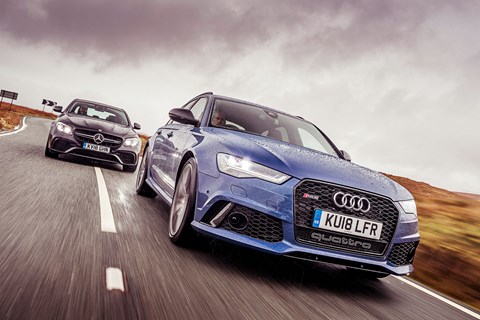
And almost never with RS-badged Audis. But what does get talked about is their ability to blitz the competition when you open the taps, sinking that shiny aluminium throttle to the bulkhead and holding it there, watching rivals fade on rain-soaked roads. But not this time. It’s the Audi, the car that always prided itself at getting away quicker than Fred Flintstone when the whistle blows, that lands the wooden spoon, taking an extra three tenths to hit 62 than its rivals, and never feeling as urgent as its Benz and BMW rivals beyond there.
But while it might have the least torque here, the RS6 spreads it more evenly, that 516lb ft peak stretching all the way from 1750rpm to 6000 and giving this wagon an effortlessly rapid feel. In character, it’s pure GT, like a repurposed Bentley, breaking speed limits, breaking long chains of dawdlers on two-lane roads without breaking a sweat, and doing it all to a backing track of muted menace. It’s no coincidence that the British carmaker uses a variation of this same V8 in its own Continental.
Inside the supercar killers
The RS6’s quilted upholstery has something of the Bentley about it, too. With acres of carbon and sporty-looking aluminium trim, perforated leather and alcantara, there’s nothing old-worlde about the ambience. But it’s definitely feeling its age. The generation of A6 that underpins this RS6 first appeared in 2011 and the dash architecture shows it. So do details like the ugly disc slot that takes up prime real estate in the middle of the dash, the small, slightly fuzzy media display, and the MMI rotary system that controls it – honed over years, but now abandoned in favour of twin touchscreens on the latest big Audis.

In contrast the Porsche interior couldn’t feel more contemporary if its was being beamed down from a 24-hour cable news helicopter. Like a live broadcast, though, this one has its problems: the volume button is annoyingly located behind the gear selector, the buttons on the console can require a couple of presses to operate, and while Porsche has tidied up the mess of switches that were scattered all over the old car’s interior, too many of them have been re-homed in the huge touchscreen media system. But it feels special in here like the other cars don’t, and that’s a feeling you get wherever you’re sitting. Only in the Porsche are rear passengers treated with the same respect as those in the front.
Of the two remaining cars it’s the older AMG that feels the freshest and most exciting from the inside. Even having watched this style of interior trickle down to the humble A-Class hasn’t diminished the shock of that expanse of digital display, or the ’30s-inspired air vents with their Bentley-style organ stops and watch-geek-pleasing IWC clock.

The BMW’s cabin feels more claustrophobic, not helped by a seat that always seems to be mounted too high. While the materials are good quality, it’s shorter on what sales people call ‘surprise and delight’ than a Victorian prison menu. If someone said this was an eight-year-old car, you’d believe them… right up until they unleashed all 600 horses and pinned you to those sexy new bucket seats, because no production M5 ever went like this before.
It’s not a car you can climb into, go crazy and understand in just a mile. Partly because it’s so fast it takes time for your brain to catch up. But also because it feels so nimble after the others, and after its F10 predecessor. That car was a weapons-grade A-road rocket, but it was big and heavy and felt slightly aloof after the personality-laden V10 version it replaced. But despite the switch to four-wheel drive, this one feels more M3 than M5. Thanks to the use of this generation 5-series’ lighter shell, and M5 goodies like a carbon roof, BMW cut 15kg from the kerbweight for the latest car. But flick it through a couple of consecutive directions changes and it feels more like 10 times that.
Behind the wheel
With a wider set of front tyres than the AMG and a narrow pair at the back you can lean harder on the BMW’s nose, and have a better sense of balance when loading up the rear as the weight shifts. It’s properly playful, and you don’t need to engage two-wheel drive to unleash it – the mid-setting Sport 4WD mode will never leave you feeling shortchanged away from a proper racetrack.
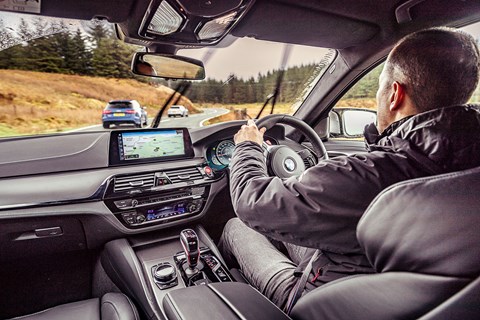
The truth is you don’t need to switch either the BMW or the AMG to two-wheel drive to have fun. It’s not like you have to make a choice between traction and entertainment. Even in four-wheel-drive mode they both feel massively rear-biased. But if you’re determined, it’s the BMW that makes disconnecting those front shafts easier. We used the left and right M buttons on the steering wheel to store two configurations – one rear-drive and one four – and spent the day flicking between them as our mood changed and torrential rain gave way to a late-afternoon flourish of sunshine.
You don’t get that breadth of performance with the Porsche, but it certainly felt wide. It handles its mass well thanks to its excellent air springing and active anti-roll bars, and when you push hard you can feel it rotate as the four-wheel steering tries to shrink the wheelbase. But you’re always aware of the extra weight and its ruthless, slightly military approach to dismantling a good road. As such it feels more like the old M5, when the new version has just opened our eyes to something else.

What hope for the RS6, then? Never the most engaging car in its class when new, it was a big ask to expect it to thrill like the M5. But it’s fun to hustle in its own way. You come back to that GT feel, the way you can stroke it along at huge speed with such little effort, stomping on the hugely powerful brakes to haul it up before a corner, or maybe just steamroll straight through knowing the quattro system has your back. There’s plenty to be said for that in a car designed to cover tens of thousands of miles every year.
The final thoughts
The Audi still has plenty to offer: proper road presence, comparatively affordable lease deals, effortless performance and a no-nonsense ground-covering ability that comes from Audi’s famed four-wheel-drive traction. And the big surprise here is how well it rides. It’s the all-weather everyday supercar you always imagined you’d have in your fantasy garage alongside your real supercar, and it still has the swagger to swivel heads on any street.
But it feels old in too many areas – and worse than that, it’s lost its USP. In the past you’d forgive the RS6 for being a little heavy and a little dull in the corners because that quattro-ness was a worthwhile pay-off. But when rivals can demolish the RS6 in a straight line, deliver more laughs in the corners and still give you quattro-like security, who wants to compromise? Now the others have joined the all-wheel-drive party the RS6 suddenly looks much less alluring.
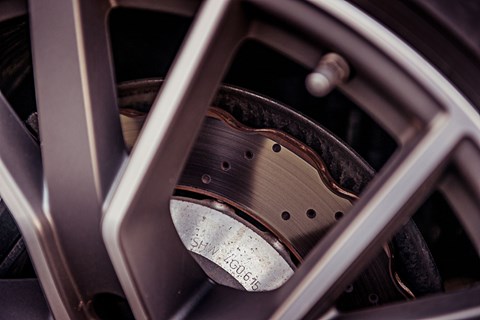
So does the Panamera, unless you can convince yourself it’s worth that big price difference. Drive down any street drinking in the stares and you’re never in doubt that as a piece of design and as a statement (and as proof that the entire UK road network needs to be widened by 2ft) the Porsche is the most special here. It’s rare, distinctive, the interior looks spectacular and yes, it’s got that famous Stuttgart crest on the nose. The Panamera serves up masses of feelgood factor and it’s far more wieldy than you’d expect. But is that enough to justify that £30k premium? It might be if it were more practical than the estate version of the AMG or more fun to drive than the BMW. But in the end it’s neither.
For £1915 more than the saloon we’ve tested here, AMG will sell you a five-door E63 S that’s every bit as mischievous as this saloon, and that’s a whole lot more mischievous than the Audi, but still with the security of four-wheel drive. Factor in the superior interior, the better boot space and the naughtier soundtrack, and it doesn’t matter whether you never go near the AMG’s drift mode. It’s simply more fun than the Audi or Porsche. If you want an unhinged estate, the AMG E63 S, a garrulous hot rod with a fine interior and a soundtrack that’s all natural, is your car.
But if we’re talking classic three-box batshit supersaloons and you want the very best, it’s a slightly different story. The AMG sounds better and its interior feels so much more of an event. And on the road it runs the BMW close, but not close enough. Rip down a deserted B-road at a supercar clip then turn it down for the commute home and you’re reminded why we’ve always loved fast four-doors, why we’ve always love the M5 in particular, and why this one is the best yet.

M5 vs E63 S vs RS6 vs Panamera Turbo ST: verdict
First place: BMW M5
Once again the definitive supersaloon.
Second place: Mercedes E63 S saloon
Hilarious hot-rodded Benz offers estate derivative BMW doesn’t.
Third place: Porsche Panamera Turbo Sport Turismo
Striking looks, shocking price and BMW drives better.
Fourth place: Audi RS6 Performance
Still plenty to offer but no longer unique.
Check out our comparison tests here